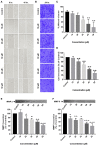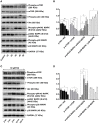Rotundic Acid Induces DNA Damage and Cell Death in Hepatocellular Carcinoma Through AKT/mTOR and MAPK Pathways
- PMID: 31293977
- PMCID: PMC6606729
- DOI: 10.3389/fonc.2019.00545
Rotundic Acid Induces DNA Damage and Cell Death in Hepatocellular Carcinoma Through AKT/mTOR and MAPK Pathways
Abstract
Hepatocellular carcinoma (HCC) is the fourth largest cause of cancer-related deaths worldwide with limited therapeutic interventions. Renewed interest in natural products as drug leads has resulted in a paradigm shift toward the rapid screening of medicinal plants for the discovery of new chemical entities. Rotundic acid (RA), a plant-derived triterpenoid, has been anecdotally reported to possess anti-inflammatory and cardio-protective abilities. The present study highlights the anti-cancer efficacy of RA on HCC in vitro and in vivo. The inhibitory effects of RA on HCC cell viability was determined by MTT. Soft agar colony formation and clonogenic assays also showed that RA inhibited HCC cell proliferation. Flow cytometry, confocal, and western blot results further indicated that RA induced cell cycle arrest, DNA damage, and apoptosis by modulating the AKT/mTOR and MAPK pathways. Besides the suppression of migration and invasion, tube formation and VEGF-ELISA revealed the anti-angiogenic abilities of RA on HCC. Moreover, RA also inhibited tumor growth in a HepG2 xenograft mouse model. To our best knowledge, this is the first extensive study of the anticancer activity of RA on HCC. The results demonstrate that RA could be a potential drug candidate for HCC treatment.
Keywords: DNA damage; anti-angiogenesis; apoptosis; hepatocellular carcinoma; rotundic acid.
Figures









Similar articles
-
Preclinical efficacy of a novel dual PI3K/mTOR inhibitor, CMG002, alone and in combination with sorafenib in hepatocellular carcinoma.Cancer Chemother Pharmacol. 2019 Oct;84(4):809-817. doi: 10.1007/s00280-019-03918-y. Epub 2019 Aug 5. Cancer Chemother Pharmacol. 2019. PMID: 31385002
-
Linalool induces cell cycle arrest and apoptosis in HepG2 cells through oxidative stress generation and modulation of Ras/MAPK and Akt/mTOR pathways.Life Sci. 2018 Apr 15;199:48-59. doi: 10.1016/j.lfs.2018.03.006. Epub 2018 Mar 3. Life Sci. 2018. PMID: 29510199
-
Haprolid Inhibits Tumor Growth of Hepatocellular Carcinoma through Rb/E2F and Akt/mTOR Inhibition.Cancers (Basel). 2020 Mar 6;12(3):615. doi: 10.3390/cancers12030615. Cancers (Basel). 2020. PMID: 32155915 Free PMC article.
-
Secalonic Acid-F, a Novel Mycotoxin, Represses the Progression of Hepatocellular Carcinoma via MARCH1 Regulation of the PI3K/AKT/β-catenin Signaling Pathway.Molecules. 2019 Jan 22;24(3):393. doi: 10.3390/molecules24030393. Molecules. 2019. PMID: 30678274 Free PMC article.
-
Efficacy of Rotundic Acid and Its Derivatives as Promising Natural Anticancer Triterpenoids: A Literature-Based Study.Chem Biodivers. 2024 Feb;21(2):e202301492. doi: 10.1002/cbdv.202301492. Epub 2024 Feb 1. Chem Biodivers. 2024. PMID: 38150556 Review.
Cited by
-
Targeting mTOR as a Cancer Therapy: Recent Advances in Natural Bioactive Compounds and Immunotherapy.Cancers (Basel). 2022 Nov 10;14(22):5520. doi: 10.3390/cancers14225520. Cancers (Basel). 2022. PMID: 36428613 Free PMC article. Review.
-
Effects of Sinapic Acid Combined with Cisplatin on the Apoptosis and Autophagy of the Hepatoma Cells HepG2 and SMMC-7721.Evid Based Complement Alternat Med. 2021 Oct 12;2021:6095963. doi: 10.1155/2021/6095963. eCollection 2021. Evid Based Complement Alternat Med. 2021. PMID: 34675987 Free PMC article.
-
Rotundic acid improves nonalcoholic steatohepatitis in mice by regulating glycolysis and the TLR4/AP1 signaling pathway.Lipids Health Dis. 2023 Dec 4;22(1):214. doi: 10.1186/s12944-023-01976-z. Lipids Health Dis. 2023. PMID: 38049817 Free PMC article.
-
Antineoplastic Activity of Chrysin against Human Hepatocellular Carcinoma: New Insight on GPC3/SULF2 Axis and lncRNA-AF085935 Expression.Int J Mol Sci. 2020 Oct 15;21(20):7642. doi: 10.3390/ijms21207642. Int J Mol Sci. 2020. PMID: 33076548 Free PMC article.
-
Targeting the mTOR Pathway in Hepatocellular Carcinoma: The Therapeutic Potential of Natural Products.J Inflamm Res. 2024 Dec 6;17:10421-10440. doi: 10.2147/JIR.S501270. eCollection 2024. J Inflamm Res. 2024. PMID: 39659752 Free PMC article. Review.
References
LinkOut - more resources
Full Text Sources
Miscellaneous

